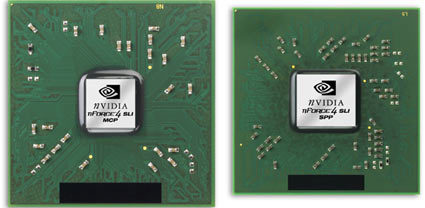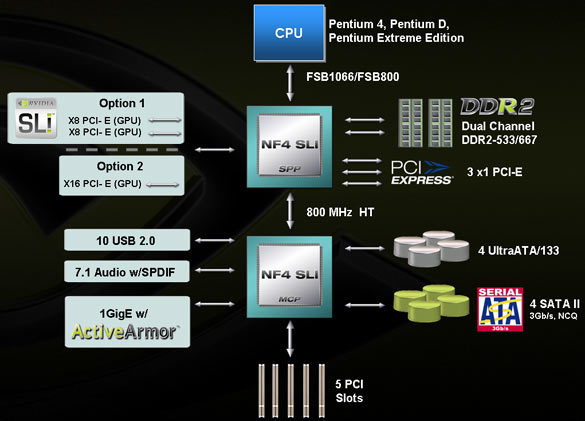NVIDIA nForce4 Intel Edition Sets Its Sights on Intel 925XE
nForce4 Intel Edition In Detail
The nForce4 IE uses the classic chipset design, which consists of two components called the north bridge and the south bridge. NVIDIA has slightly different names for these units, calling them the System Platform Processor (SPP) and the Media and Communications Processor (MCP) respectively. The SPP consists of the brand new DDR2 memory controller and a total of 19 PCI Express lanes. 16 lanes are used either for single graphics (x16 PCIe) or for SLI dual graphics (two x16 connectors running in x8 mode each). The remaining ones run three x1 PCIe ports.
The MCP incorporates a 7.1 sound system (no SoundStorm though), ten USB 2.0 ports, and NVIDIA's Gigabit Ethernet interface, including their hardware firewall called ActiveArmor. Five 32 bit PCI slots can be used. The storage subsystem contains two UltraATA channels and four SATA ports with full support for native command queuing and 3 GBit/s operation. NVIDIA merged the storage subsystem under the name MediaShield.
One very interesting detail is that the SPP and MCP do not communicate via PCI Express as you might have expected. NVIDIA decided to deploy the HyperTransport protocol, which powers significant areas of the AMD64 infrastructure. This decision makes sense, since the firm already has quite a bit of experience with HyperTransport thanks to the nForce4 chipset for the Athlon platform.
Also note that the MCP does not feature any PCI Express component; instead, everything has been integrated into the SPP. Finally, NVIDIA does not support DDR400 SDRAM, only DDR2-533 and DDR2-667. According to the technical documents we received, legacy memory support would have had a negative impact on memory performance. As you read on, you will see the significance of this decision.
Get Tom's Hardware's best news and in-depth reviews, straight to your inbox.
Current page: nForce4 Intel Edition In Detail
Prev Page nForce4 Intel Edition Kicking Intel's 925XE Next Page Memory Optimizations
Patrick Schmid was the editor-in-chief for Tom's Hardware from 2005 to 2006. He wrote numerous articles on a wide range of hardware topics, including storage, CPUs, and system builds.

